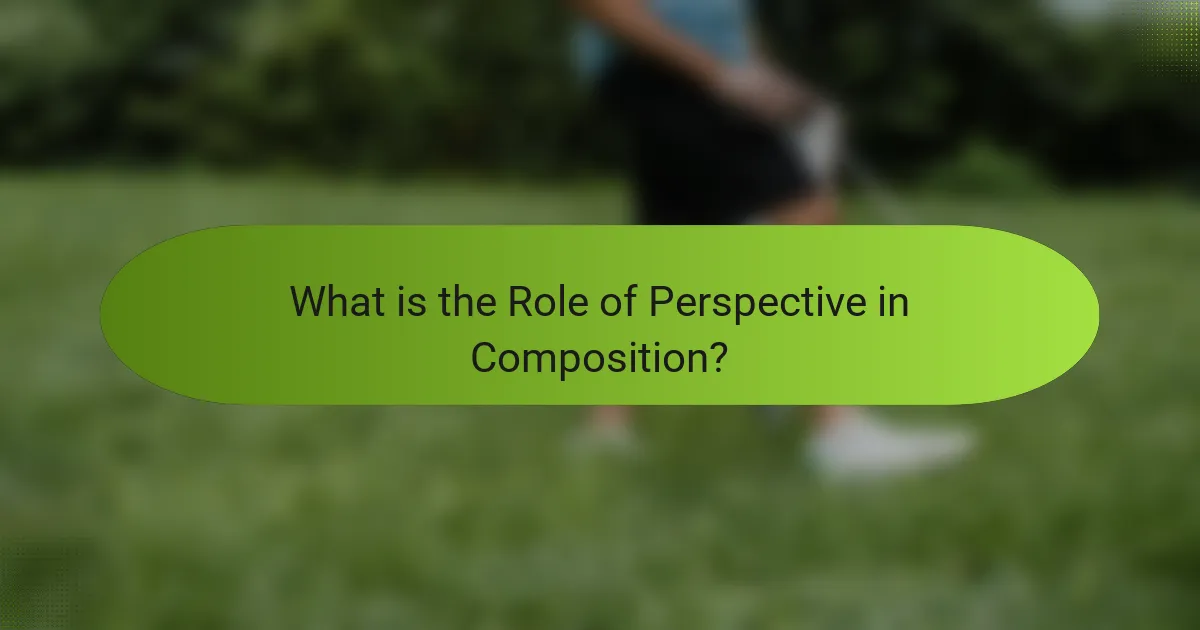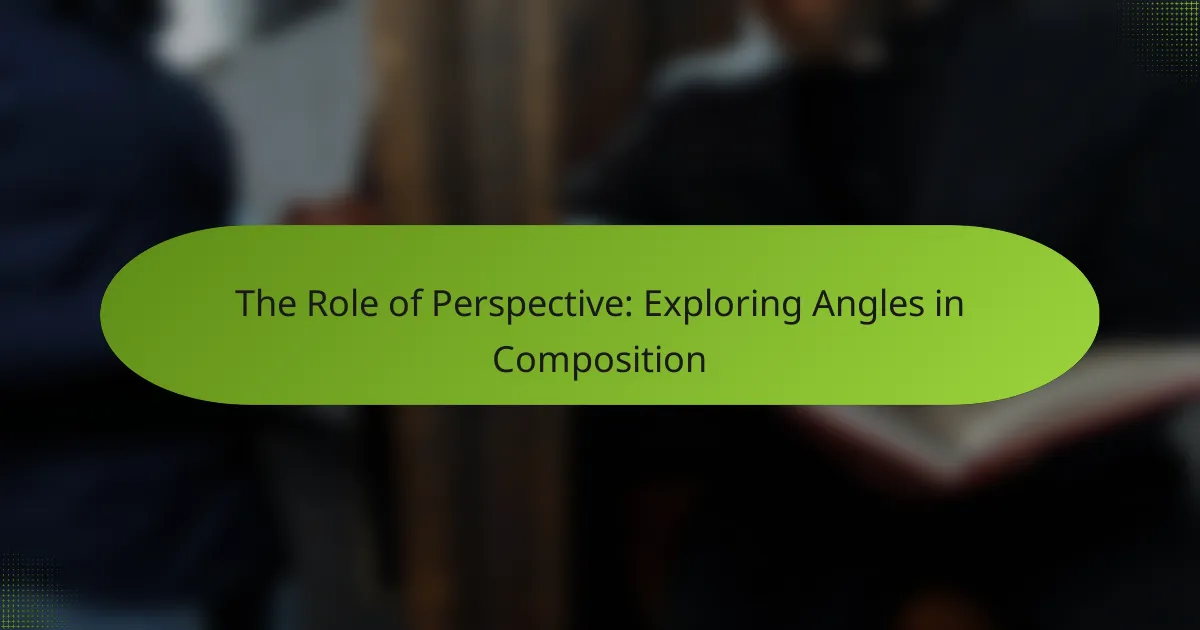
What is the Role of Perspective in Composition?
Perspective in composition refers to the viewpoint from which a subject is depicted. It shapes the visual narrative and influences how the audience perceives the subject. Different perspectives can alter the emotional impact and meaning of an image. For example, a low angle can evoke power, while a high angle can suggest vulnerability. The choice of perspective directs the viewer’s attention and guides interpretation. Effective use of perspective enhances storytelling in visual art and photography. Studies in visual perception show that perspective significantly affects viewer engagement and response.
How does perspective influence visual storytelling?
Perspective shapes visual storytelling by determining how viewers interpret images. It affects the composition, focus, and emotional impact of a scene. Different angles can evoke varying feelings and responses. For instance, a low angle can convey power, while a high angle may suggest vulnerability. This technique is evident in films, where directors manipulate perspective to guide audience perception. Studies in visual communication show that perspective significantly influences viewer engagement and narrative understanding. By altering perspective, storytellers can enhance thematic depth and character development.
What are the different types of perspective used in composition?
The different types of perspective used in composition include one-point perspective, two-point perspective, and three-point perspective. One-point perspective creates depth by converging parallel lines to a single vanishing point on the horizon. Two-point perspective uses two vanishing points on the horizon, enhancing realism in depicting objects at an angle. Three-point perspective adds a third vanishing point, typically above or below the horizon, allowing for dramatic views of tall structures or deep spaces. These perspectives are foundational in art and design, helping to create a sense of space and dimensionality.
How does perspective affect the viewer’s perception of depth?
Perspective significantly influences a viewer’s perception of depth. It alters how objects are spatially arranged in relation to each other. Linear perspective, for example, uses converging lines to create an illusion of distance. This technique helps the viewer understand which objects are closer and which are farther away. Additionally, atmospheric perspective uses color and clarity to indicate depth. Distant objects appear lighter and less detailed compared to those nearby. Research in visual perception supports these concepts, confirming that perspective cues are vital for depth perception. Studies show that accurate perspective enhances the realism of images, making them more engaging to viewers.
Why is understanding angles important in composition?
Understanding angles is important in composition because they influence visual balance and perspective. Angles determine how subjects relate to one another within a frame. They affect the viewer’s perception and emotional response. For example, acute angles can create tension, while obtuse angles can evoke calmness. Proper use of angles enhances storytelling in visual arts. Studies show that compositions with intentional angles engage viewers more effectively. Understanding angles allows artists to direct the viewer’s eye and highlight focal points. This knowledge is essential for creating dynamic and compelling compositions.
What are the key angles that can be utilized in visual arts?
Key angles utilized in visual arts include the eye level angle, high angle, low angle, and bird’s-eye view. The eye level angle captures the subject at the viewer’s height. It creates a sense of realism and neutrality. A high angle looks down on the subject, often conveying vulnerability or insignificance. Conversely, a low angle looks up at the subject, imparting power or dominance. The bird’s-eye view presents a scene from directly above, offering a unique perspective that can emphasize patterns or relationships. Each angle influences the viewer’s perception and emotional response to the artwork.
How do different angles change the emotional impact of an image?
Different angles significantly alter the emotional impact of an image. High angles often evoke feelings of vulnerability or insignificance. Conversely, low angles can create a sense of power or dominance. Eye-level angles tend to present a neutral perspective, fostering relatability.
The angle of view affects how subjects are perceived. For instance, a tilted angle can suggest tension or unease. Research indicates that angles can influence viewer interpretation and emotional response. A study by M. A. W. van der Laan et al. (2018) found that perspective shapes emotional engagement with visual content.
In summary, angles are crucial in conveying emotions through imagery. They can manipulate perception and influence how an image is experienced.

How does perspective enhance the composition of an artwork?
Perspective enhances the composition of an artwork by creating depth and spatial relationships. It allows the viewer to perceive distance and scale within the piece. This technique guides the viewer’s eye through the composition. Linear perspective uses converging lines to simulate three-dimensional space on a two-dimensional surface. Atmospheric perspective employs color and clarity to depict distance, making objects appear lighter and less distinct as they recede. Historical examples include Leonardo da Vinci’s “The Last Supper,” which uses perspective to draw focus to [censured]. The effective use of perspective can evoke emotions and enhance storytelling in visual art.
What role does perspective play in creating focal points?
Perspective significantly influences the creation of focal points in visual composition. It determines how viewers perceive depth, distance, and importance within an image. By manipulating perspective, artists can guide the viewer’s eye to specific areas. For instance, using a low angle can elevate a subject, making it appear more prominent. Conversely, a high angle can diminish the subject’s significance. The choice of perspective also affects the spatial relationship between elements. This spatial arrangement can create tension or harmony, enhancing the focal point’s impact. Research in visual perception shows that perspective shifts can alter emotional responses to an image. Therefore, perspective is a crucial tool for directing attention and establishing focal points in composition.
How can perspective guide the viewer’s eye throughout the composition?
Perspective can guide the viewer’s eye by creating depth and leading lines in a composition. It establishes a visual pathway that draws attention to focal points. Techniques such as linear perspective align parallel lines to converge at a vanishing point. This convergence naturally directs the viewer’s gaze toward the center of interest. Additionally, atmospheric perspective uses color and clarity to enhance depth perception. By manipulating scale and placement, artists can emphasize certain elements over others. The strategic use of perspective can thus enhance the overall narrative of the artwork. Studies show that viewers instinctively follow lines and shapes that lead their eyes through a scene.
What techniques can artists use to emphasize perspective in their work?
Artists can use techniques such as linear perspective, atmospheric perspective, and foreshortening to emphasize perspective in their work. Linear perspective involves creating a sense of depth by converging parallel lines towards a vanishing point. This technique was notably used by artists like Leonardo da Vinci in “The Last Supper.” Atmospheric perspective relies on color and clarity to create depth, with distant objects appearing lighter and less detailed. This method is evident in works by Claude Monet, where background elements are softened. Foreshortening alters the proportions of objects to create a sense of depth, making objects closer appear larger. This technique is exemplified in Michelangelo’s “The Creation of Adam.” Each of these methods enhances the viewer’s perception of space and distance in artwork.
How does the choice of perspective affect narrative elements?
The choice of perspective significantly affects narrative elements. It determines how much information the audience receives about characters and events. First-person perspective provides intimate access to a character’s thoughts and feelings. This creates a strong emotional connection for the reader. Third-person omniscient perspective offers a broader view of the story. It allows insight into multiple characters’ motivations and backgrounds.
Additionally, perspective influences the reliability of the narrative. A first-person narrator may be biased or limited in their understanding. This can create tension or suspense. In contrast, a third-person narrator can present a more objective account.
Furthermore, the choice of perspective shapes the tone and style of the narrative. A first-person perspective may convey a personal and subjective tone. Conversely, a third-person perspective can adopt a more formal or detached style.
Overall, the perspective chosen directly impacts character development, plot progression, and reader engagement.
What are the implications of using a high versus low angle perspective?
High angle perspectives typically convey a sense of vulnerability or powerlessness. They make subjects appear smaller and less significant. This can evoke empathy or emphasize a character’s weakness. In contrast, low angle perspectives suggest dominance and strength. They can make subjects appear larger and more imposing. This perspective can instill a sense of awe or intimidation. Studies in visual composition show that angle affects viewer perception significantly. For instance, a low angle shot of a leader can enhance their authority. Conversely, a high angle shot of a character in distress can elicit sympathy.
How can perspective shape the story being told through composition?
Perspective significantly shapes the story conveyed through composition. It influences how viewers interpret the subject matter. Different angles can evoke various emotions and responses. For instance, a low-angle shot can make a subject appear powerful. Conversely, a high-angle shot can suggest vulnerability. The choice of perspective can also highlight specific details or themes. By framing elements differently, the narrative focus shifts accordingly. This technique is widely used in photography and film to enhance storytelling. Studies show that perspective affects audience engagement and perception.

What are the practical applications of perspective in composition?
Perspective in composition is essential for creating depth and dimension in visual art and photography. It allows artists to manipulate spatial relationships between objects and the viewer. By using techniques such as linear perspective, artists can guide the viewer’s eye through a scene. This technique creates an illusion of three-dimensionality on a two-dimensional surface.
In photography, perspective influences the mood and narrative of an image. Different angles and focal lengths can alter the perceived importance of subjects within the frame. For instance, a low angle can make a subject appear more powerful. Conversely, a high angle can evoke feelings of vulnerability.
Additionally, perspective helps in storytelling by establishing context and emphasizing relationships between elements. For example, foreground and background elements can create layers of interest. This layering enhances visual storytelling and engages the viewer more effectively.
Overall, practical applications of perspective in composition include enhancing realism, guiding viewer attention, influencing emotional responses, and enriching visual narratives.
How can photographers effectively use perspective in their shots?
Photographers can effectively use perspective by varying their shooting angles and distances. Changing the height of the camera alters how subjects are perceived. Low angles can make subjects appear more powerful, while high angles can create a sense of vulnerability. Additionally, using leading lines directs the viewer’s eye and enhances depth. Incorporating foreground elements can add layers to the composition. Techniques like the rule of thirds can also help position subjects effectively within the frame. These methods create dynamic images that engage viewers. Studies show that perspective significantly impacts visual storytelling in photography.
What tips can help artists master the use of perspective?
To master the use of perspective, artists should practice drawing from real life. Observing objects in three-dimensional space helps understand depth. Using vanishing points is essential for creating realistic scenes. Artists should also study one-point and two-point perspective techniques. Sketching grids can aid in maintaining accurate proportions. Experimenting with different angles enhances spatial awareness. Regularly analyzing perspective in master artworks provides valuable insights. Engaging in exercises that focus on foreshortening improves representation of objects at varying distances.
What common mistakes should be avoided when working with perspective?
Common mistakes to avoid when working with perspective include inconsistent vanishing points. This leads to confusion in spatial relationships. Another mistake is neglecting the horizon line, which can distort the viewer’s sense of scale. Failing to use proper foreshortening can also misrepresent objects in space. Additionally, overcomplicating scenes with too many elements can overwhelm the viewer. Ignoring light and shadow can result in a flat appearance. Lastly, not practicing regularly can hinder the development of perspective skills. These mistakes can significantly impact the overall effectiveness of a composition.
How can one identify and correct perspective errors in composition?
To identify and correct perspective errors in composition, one should first analyze the alignment of objects within the frame. Checking for consistent vanishing points is essential. Observing the scale of objects in relation to one another helps reveal discrepancies. Techniques like using a grid can assist in maintaining correct proportions. Additionally, reviewing the composition from various angles can highlight errors. Comparing the composition to reference images can provide clarity. It is important to adjust the positioning of elements to enhance depth. These methods ensure a more accurate representation of perspective in the artwork.
The main entity of the article is perspective in composition, which refers to the viewpoint from which a subject is depicted in visual art and photography. The article explores how perspective influences visual storytelling, emotional impact, and the perception of depth through various types of angles, including one-point, two-point, and three-point perspectives. It highlights the importance of understanding angles in composition, detailing how they can guide viewer attention and create focal points. Additionally, the article addresses practical applications of perspective, common mistakes to avoid, and techniques for mastering perspective in artistic work.
